[English] 日本語
 Yorodumi
Yorodumi- PDB-7k3s: Solution NMR Structure of the Coiled-coil BRCA1-PALB2 Heterodimer -
+ Open data
Open data
- Basic information
Basic information
| Entry | Database: PDB / ID: 7k3s | ||||||||||||
|---|---|---|---|---|---|---|---|---|---|---|---|---|---|
| Title | Solution NMR Structure of the Coiled-coil BRCA1-PALB2 Heterodimer | ||||||||||||
 Components Components |
| ||||||||||||
 Keywords Keywords | ONCOPROTEIN / Homologous Recombination / DNA | ||||||||||||
| Function / homology |  Function and homology information Function and homology informationlocalization / Presynaptic phase of homologous DNA pairing and strand exchange / Homologous DNA Pairing and Strand Exchange / Resolution of D-loop Structures through Holliday Junction Intermediates / SUMOylation of DNA damage response and repair proteins / G2/M DNA damage checkpoint / HDR through Single Strand Annealing (SSA) / Nonhomologous End-Joining (NHEJ) / HDR through Homologous Recombination (HRR) / Metalloprotease DUBs ...localization / Presynaptic phase of homologous DNA pairing and strand exchange / Homologous DNA Pairing and Strand Exchange / Resolution of D-loop Structures through Holliday Junction Intermediates / SUMOylation of DNA damage response and repair proteins / G2/M DNA damage checkpoint / HDR through Single Strand Annealing (SSA) / Nonhomologous End-Joining (NHEJ) / HDR through Homologous Recombination (HRR) / Metalloprotease DUBs / BRCA1-BARD1 complex / BRCA1-B complex / Processing of DNA double-strand break ends / BRCA1-A complex / BRCA1-C complex / Recruitment and ATM-mediated phosphorylation of repair and signaling proteins at DNA double strand breaks / sex-chromosome dosage compensation / random inactivation of X chromosome / chordate embryonic development / nuclear ubiquitin ligase complex / cellular response to indole-3-methanol / negative regulation of intracellular estrogen receptor signaling pathway / DNA strand resection involved in replication fork processing / Regulation of TP53 Activity through Phosphorylation / negative regulation of fatty acid biosynthetic process / homologous recombination / protein K6-linked ubiquitination / post-anal tail morphogenesis / lateral element / regulation of DNA damage checkpoint / XY body / mitotic G2/M transition checkpoint / RNA polymerase binding / DNA damage tolerance / DNA repair complex / centrosome cycle / inner cell mass cell proliferation / DNA-binding transcription activator activity / negative regulation of gene expression via chromosomal CpG island methylation / mitotic G2 DNA damage checkpoint signaling / mesoderm development / centrosome duplication / negative regulation of reactive oxygen species metabolic process / positive regulation of vascular endothelial growth factor production / embryonic organ development / somitogenesis / negative regulation of extrinsic apoptotic signaling pathway via death domain receptors / regulation of DNA repair / protein autoubiquitination / positive regulation of cell cycle / condensed chromosome / positive regulation of DNA repair / animal organ morphogenesis / condensed nuclear chromosome / cellular response to ionizing radiation / male germ cell nucleus / chromosome segregation / negative regulation of cell growth / double-strand break repair via homologous recombination / RING-type E3 ubiquitin transferase / positive regulation of protein import into nucleus / multicellular organism growth / positive regulation of angiogenesis / intrinsic apoptotic signaling pathway in response to DNA damage / ubiquitin-protein transferase activity / fatty acid biosynthetic process / cellular response to tumor necrosis factor / p53 binding / double-strand break repair / chromosome / in utero embryonic development / damaged DNA binding / transcription coactivator activity / transcription cis-regulatory region binding / nuclear speck / nuclear body / mitochondrial matrix / ribonucleoprotein complex / DNA repair / negative regulation of DNA-templated transcription / apoptotic process / DNA damage response / ubiquitin protein ligase binding / centrosome / chromatin binding / regulation of transcription by RNA polymerase II / negative regulation of apoptotic process / positive regulation of DNA-templated transcription / positive regulation of transcription by RNA polymerase II / protein-containing complex / DNA binding / RNA binding / zinc ion binding / nucleoplasm / identical protein binding / nucleus / plasma membrane / cytoplasm Similarity search - Function | ||||||||||||
| Biological species |  | ||||||||||||
| Method | SOLUTION NMR / simulated annealing | ||||||||||||
 Authors Authors | Daigham, N.S. / Liu, G. / Bunting, S.F. / Montelione, G.T. | ||||||||||||
| Funding support |  United States, 3items United States, 3items
| ||||||||||||
 Citation Citation |  Journal: To Be Published Journal: To Be PublishedTitle: The Structural Basis for Interactions Between PALB2 and BRCA1 that Mediate the Homologous Recombination DNA Damage Repair Process Authors: Daigham, N.S. / Liu, G. / Bunting, S.F. / Montelione, G.T. #1:  Journal: Biochemistry / Year: 2018 Journal: Biochemistry / Year: 2018Title: Antiparallel Coiled-Coil Interactions Mediate the Homodimerization of the DNA Damage-Repair Protein PALB2. Authors: Song, F. / Li, M. / Liu, G. / Swapna, G.V.T. / Daigham, N.S. / Xia, B. / Montelione, G.T. / Bunting, S.F. | ||||||||||||
| History |
|
- Structure visualization
Structure visualization
| Structure viewer | Molecule:  Molmil Molmil Jmol/JSmol Jmol/JSmol |
|---|
- Downloads & links
Downloads & links
- Download
Download
| PDBx/mmCIF format |  7k3s.cif.gz 7k3s.cif.gz | 703.2 KB | Display |  PDBx/mmCIF format PDBx/mmCIF format |
|---|---|---|---|---|
| PDB format |  pdb7k3s.ent.gz pdb7k3s.ent.gz | 598.9 KB | Display |  PDB format PDB format |
| PDBx/mmJSON format |  7k3s.json.gz 7k3s.json.gz | Tree view |  PDBx/mmJSON format PDBx/mmJSON format | |
| Others |  Other downloads Other downloads |
-Validation report
| Arichive directory |  https://data.pdbj.org/pub/pdb/validation_reports/k3/7k3s https://data.pdbj.org/pub/pdb/validation_reports/k3/7k3s ftp://data.pdbj.org/pub/pdb/validation_reports/k3/7k3s ftp://data.pdbj.org/pub/pdb/validation_reports/k3/7k3s | HTTPS FTP |
|---|
-Related structure data
| Related structure data | |
|---|---|
| Similar structure data | |
| Other databases |
|
- Links
Links
- Assembly
Assembly
| Deposited unit | 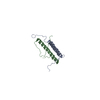
| |||||||||
|---|---|---|---|---|---|---|---|---|---|---|
| 1 |
| |||||||||
| NMR ensembles |
|
- Components
Components
| #1: Protein | Mass: 6935.690 Da / Num. of mol.: 1 / Fragment: residues 1337-1387 Source method: isolated from a genetically manipulated source Source: (gene. exp.)   References: UniProt: P48754, RING-type E3 ubiquitin transferase |
|---|---|
| #2: Protein | Mass: 7948.166 Da / Num. of mol.: 1 / Fragment: residues 1-60 Source method: isolated from a genetically manipulated source Source: (gene. exp.)   |
-Experimental details
-Experiment
| Experiment | Method: SOLUTION NMR | ||||||||||||||||||||||||||||||||||||||||||||||||||||||||||||||||||||||||||||||||||||||||||||||||||||||||||||||||||||||||||||||||||||||||||||||||
|---|---|---|---|---|---|---|---|---|---|---|---|---|---|---|---|---|---|---|---|---|---|---|---|---|---|---|---|---|---|---|---|---|---|---|---|---|---|---|---|---|---|---|---|---|---|---|---|---|---|---|---|---|---|---|---|---|---|---|---|---|---|---|---|---|---|---|---|---|---|---|---|---|---|---|---|---|---|---|---|---|---|---|---|---|---|---|---|---|---|---|---|---|---|---|---|---|---|---|---|---|---|---|---|---|---|---|---|---|---|---|---|---|---|---|---|---|---|---|---|---|---|---|---|---|---|---|---|---|---|---|---|---|---|---|---|---|---|---|---|---|---|---|---|---|---|
| NMR experiment |
|
- Sample preparation
Sample preparation
| Details |
| ||||||||||||||||||||||||||||||||||||||||||||||||||||
|---|---|---|---|---|---|---|---|---|---|---|---|---|---|---|---|---|---|---|---|---|---|---|---|---|---|---|---|---|---|---|---|---|---|---|---|---|---|---|---|---|---|---|---|---|---|---|---|---|---|---|---|---|---|
| Sample |
| ||||||||||||||||||||||||||||||||||||||||||||||||||||
| Sample conditions | Details: Buffer Conditions: 20 mM MES, 200 mM NaCl, 10 mM DTT, 5 mM CaCl2 at pH 6.5 Ionic strength: 200 mM / Label: conditions_1 / pH: 6.5 / Pressure: 1 atm / Temperature: 293 K |
-NMR measurement
| NMR spectrometer | Type: Bruker AVANCE / Manufacturer: Bruker / Model: AVANCE / Field strength: 800 MHz |
|---|
- Processing
Processing
| NMR software |
| |||||||||||||||||||||||||||||||||
|---|---|---|---|---|---|---|---|---|---|---|---|---|---|---|---|---|---|---|---|---|---|---|---|---|---|---|---|---|---|---|---|---|---|---|
| Refinement | Method: simulated annealing / Software ordinal: 7 / Details: molecular dynamics | |||||||||||||||||||||||||||||||||
| NMR representative | Selection criteria: lowest energy | |||||||||||||||||||||||||||||||||
| NMR ensemble | Conformer selection criteria: target function / Conformers calculated total number: 200 / Conformers submitted total number: 15 |
 Movie
Movie Controller
Controller


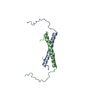
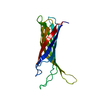
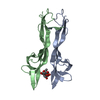
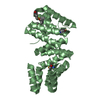

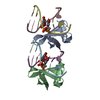

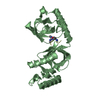

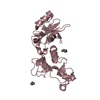
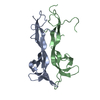
 PDBj
PDBj






 HSQC
HSQC